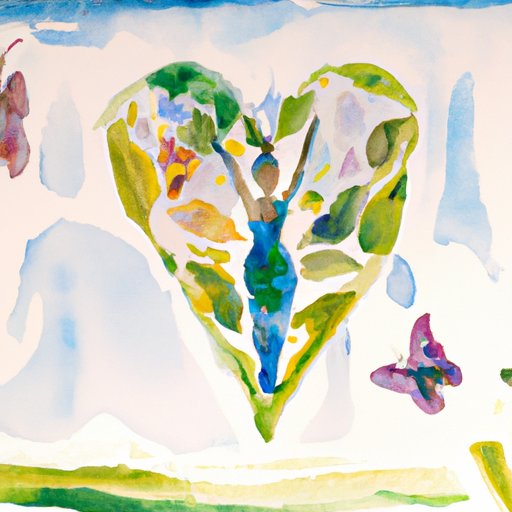Introduction
The phrase “A thing of beauty is a joy forever” is often attributed to the English poet John Keats, who wrote it in his 1819 poem Endymion. This phrase has been used to refer to the idea that beauty is timeless and can bring lasting happiness. But what does this phrase really mean? In this article, we will explore the meaning of “A thing of beauty is a joy forever” and examine its impact on emotional well-being, art and culture, psychology, social interactions, self-esteem, and transformation.
Analyzing the Impact of Beauty on Emotional Well-Being
When we encounter something beautiful, it can evoke positive emotions such as awe, joy, and admiration. Studies have shown that looking at or listening to something beautiful can reduce stress, lower heart rate, and even increase feelings of happiness. For example, one study found that participants who looked at pictures of beautiful landscapes experienced a decrease in cortisol (a hormone associated with stress) compared to those who looked at neutral images.
In addition to providing short-term relief from stress, beauty can also have long-term benefits for emotional well-being. Research has shown that people who live in areas with more natural beauty are more likely to report higher levels of life satisfaction and better mental health. The calming effect of beauty can also help people become more mindful and aware of their surroundings, which can lead to improved mental clarity and increased focus.

Examining the Role of Beauty in Art and Culture
Beauty has long been an important part of art and culture. Throughout history, artists have sought to capture beauty in their works, whether it be through painting, sculpture, music, or literature. Even today, beauty remains a powerful force in the arts, with many contemporary artists striving to create works that evoke emotion and inspire wonder.
Beauty is also deeply embedded in many cultures around the world. Different cultures have different ideas of what constitutes beauty, but all cultures recognize the importance of beauty and have developed ways to incorporate it into their daily lives. From traditional clothing to religious rituals, beauty is often used to communicate values and beliefs, making it an integral part of cultural identity.

Exploring the Psychology Behind Our Perception of Beauty
Our brains are wired to appreciate beauty. Studies have shown that when people view something they consider to be beautiful, their brains release dopamine, a neurotransmitter associated with pleasure. This suggests that our perception of beauty is linked to our reward system, which helps explain why we are so drawn to things that are aesthetically pleasing.
Cultural influences also play a role in how we perceive beauty. Different cultures have different standards of beauty, so what one culture finds attractive may be seen as unattractive in another. Furthermore, beauty standards can change over time, reflecting current trends and preferences. As a result, our perception of beauty is constantly evolving.
Investigating How Beauty Influences Social Interactions
Beauty can be a powerful tool for attracting attention and influencing social dynamics. Studies have shown that people are often more likely to approach someone they find attractive, and they may also be more likely to listen to and remember what they say. This phenomenon is known as the “halo effect,” and it can give people with physical beauty an advantage in social situations.
However, beauty can also have a negative impact on social interactions. People may be judged based on their appearance, and those deemed less attractive may be treated unfairly. Moreover, relying too heavily on beauty for attention can lead to shallow relationships and missed opportunities for meaningful connections.
Examining the Relationship Between Beauty and Self-Esteem
Our self-esteem is closely tied to our perception of beauty. Many people place a great deal of value on their physical appearance, and if they feel like they don’t measure up to society’s standards of beauty, their self-esteem can suffer. This can lead to feelings of inadequacy and low self-worth, which can have serious consequences for mental health.
At the same time, it’s important to remember that beauty is only one aspect of a person’s worth. Relying too heavily on physical beauty can be dangerous, as it can lead to a distorted self-image and an unhealthy preoccupation with one’s appearance. It’s important to recognize that beauty is subjective and that there is no one “right” way to look.

Looking at the Power of Beauty to Transform Lives
Beauty has the power to transform lives in both big and small ways. On a larger scale, beauty can be used to promote social change by highlighting issues such as inequality and injustice. For example, the Black Lives Matter movement has used art and imagery to draw attention to the issue of police brutality against people of color.
On a smaller scale, beauty can be used to foster personal growth and healing. Experiences such as yoga, meditation, and nature walks can be used to tap into the power of beauty to create positive changes in one’s life. Whether it’s through creative expression or simply taking a moment to appreciate the beauty of the world around us, beauty can be a powerful tool for transformation.
Conclusion
In conclusion, “A thing of beauty is a joy forever” is more than just a poetic phrase – it’s a reminder of the power of beauty to bring lasting happiness and transformation. From improving emotional well-being to influencing social interactions, beauty can have a profound impact on our lives. By understanding the meaning behind this phrase, we can use beauty to make the world a better place.
Further research is needed to explore the full implications of beauty on our lives and how we can use it to create positive change. Ultimately, “A thing of beauty is a joy forever” reminds us of the potential beauty holds to bring joy, peace, and transformation to our lives.


